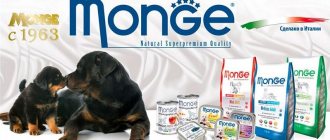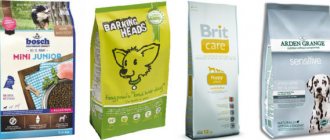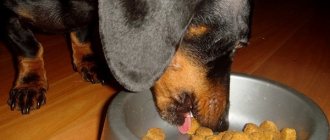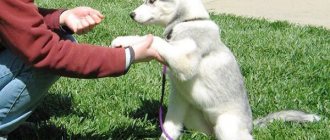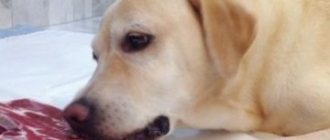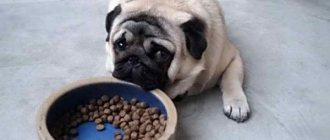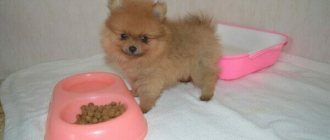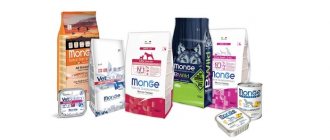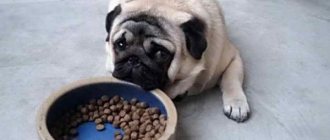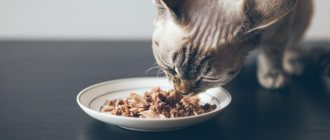The Labrador is an active, cheerful and good-natured companion dog, endlessly devoted to its owner.
Like representatives of other breeds, they have some developmental and health features, some of which are directly related to feeding.
Proper, balanced nutrition is one of the most important aspects of the health and quality of life of these dogs.
Therefore, it is very important to choose a suitable diet that includes all the substances necessary for the puppy.
Therefore, this is intended to help you decide what type of feeding to choose for your Labrador puppy.
Rating of the 10 best dry food for Labrador Retriever
| Place | Name | Rating | Price, rub. |
| 1 | Belcando Junior Maxi for large and giant breed puppies from 3 to 18 months (15 kg) | 10 / 10 | 5 214 |
| 2 | Acana Puppy Large Breed, 11.4 kg | 10 / 10 | 5 050 |
| 3 | Royal Canin Maxi Adult, 15 kg | 9 / 10 | 4785 |
| 4 | Almo Nature Holistic beef 12 kg | 9 / 10 | 4279 |
| 5 | Purina Pro Plan Optiderma for healthy skin and coat, salmon with rice, 14 kg | 8 / 10 | 4113 |
| 6 | Brit Care lamb with rice 12 kg | 9 / 10 | 3999 |
| 7 | OUR DIET WITH BEEF, 15 kg | 7 / 10 | 1670 |
| 8 | Pedigree for healthy skin and coat, beef, 13 kg | 7 / 10 | 1399 |
| 9 | CHAPPI MEAT ABUNDANCE WITH VEGETABLES AND HERBS, adults, 15kg | 7 / 10 | 1381 |
| 10 | ALL DOGS (13 kg) Dry complete | 6 / 10 | 1153 |
Dry food contains a range of vitamins and components for her active and happy life. Most breeders of these pets prefer dry nutritional granules and regularly pamper their pet with them, not forgetting to give him fresh water. Crackers consist of a complex of substances beneficial to animals - these are proteins, vitamins, minerals in the quantities that should be present for the proper development, growth, and good health of the animal. When purchasing similar food for their dog, each owner must adhere to the following criteria: age, size of the animal, its degree of physical mobility, class of nutritional granules.
Feeding natural food at home
Until the age of two months, the breeder takes care of the puppy’s nutrition. How to feed a Labrador at home? Do not change your diet for two to three weeks, and then use the following scheme:
| Feeding number | Age, months | ||||
| <3 | >3<4 | >4<6 | >6<8 | >8 | |
| 1 | milk | cottage cheese with milk | cottage cheese with kefir | ||
| 2 | cottage cheese | rice or buckwheat porridge | meat or fish with porridge or vegetables | ||
| 3 | rice porridge | vegetables | meat with vegetables | ||
| 4 | milk | meat | |||
| 5 | vegetables | ||||
| 6 | meat | ||||
What kind of cereals do Labradors eat? For puppies up to four months of age, cook rice; for older pets, alternate rice with buckwheat.
To feed a three-month-old puppy, you will need 300 ml of milk and meat, 150 g of cottage cheese and rice porridge, 100 g of vegetables, which are poured with a spoon of vegetable oil, preferably flaxseed. For a pet from 3 to 4 months, use the same components, increase their quantity by 50%. Gradually replace milk with kefir because teenagers and adults cannot tolerate milk sugar. For puppies older than 4 months, increase the amount of food by another third. From six months, replace meat with boiled fish once or twice a week. Breeders recommend giving 1 quail egg per day.
Experts advise feeding a dog over 8 months old 0.5 kg of kefir with cottage cheese in the morning, and 0.5 kg of meat or fish with 0.2 kg of vegetables or porridge in the evening. For adult dogs, some of the meat can be replaced with offal.
Watch the video:
Feeding
When choosing, you should focus on premium products that do not contain by-products that cause allergies.
Take the Attention Test! Find 10 differences! (click right here!)
Find the answer Are you bothered by some problem or question? Enter “Breed” or “Name of the problem” into the form, press Enter and you will find out everything about the issue that interests you.
Puppy food contains chondroprotectors, and to maintain the coat in good condition, the presence of prebiotics is necessary.
At the age of 6-12 months, muscle mass actively increases. Requires mineral complex.
An adult Labrador requires a stable diet, without changes in composition. With “dry” feeding, the dog receives a balanced complex, with the correct ratio of all necessary vitamins.
There are dietary foods that take into account the health and lifestyle of the dog. Eating fiber is important for bowel function. Sensitive skin needs regular replenishment of zinc, copper, iron and other elements.
Labradors are prone to obesity, eye diseases and dysplasia. To avoid this, a special mixture is selected in an individual dosage.
What type of food should I choose?
During the first month of life, the main source of nutrition for puppies is mother's milk. As they grow older, starting from the age of one month, dogs are gradually accustomed to solid food - natural products or ready-made food.
Industrial feeds are made taking into account all the needs of the animal and contain everything necessary for its proper development; they are easy to use and do not require time for preparation. In turn, natural nutrition is varied and does not contain chemical additives, but you must have certain knowledge and experience in order to create a diet correctly.
So, food must contain:
- prebiotics and easily digestible proteins that promote normal stool and proper balance of microflora, since puppies of this breed are prone to intestinal diseases;
- fatty acids necessary to maintain the quality of the coat;
- components that help strengthen joints.
There is no consensus on what food is best for Labrador puppies. Breeders unanimously speak only about the need for a balanced diet that takes into account the breed characteristics of Labradors.
Expert opinion
Tolkachev Andrey Mikhailovich
veterinarian
When the lactation period ends and the time comes to introduce complementary foods, breeders make a choice in favor of natural products or industrial feeds. Both types of nutrition have the right to exist and both have advantages and disadvantages. A natural diet is certainly beneficial for puppies, but at home it is quite problematic to prepare it correctly without disturbing the balance of nutrients and vitamins. Today, the market offers a wide range of industrial feeds produced by domestic or foreign companies, and choosing the right one for your pet is not difficult. The main thing is to purchase products of at least premium class.
Belcando Junior Maxi for large and giant breed puppies from 3 to 18 months (15 kg)
Many experts recommend Belcando Junior, made in Germany, for large dogs. Its composition is rich in a high content of poultry meat, in addition to easily digestible rice, which helps good digestion and absorption of useful components. The recipe contains carob fruits, which contain tannins and substances important for life that have an effect on proper digestion. Belongs to the super premium class.
pros
- A complete, balanced complex of nutrients.
- Healthy pet.
- Convenient, economical packaging.
- A wide range of.
- Availability.
- German quality.
Minuses
- Causes an allergic reaction.
- Not all dogs like it.
- Not sold in all Russian cities.
- Composition with sodium chloride.
- Large granules of strange color.
- Poor combination with vitamins and other products.
- There is a minimum of meat, but a maximum of cereals.
Daily norm
Strict requirements are imposed on Labrador cubs. Breeders also take care of feeding the one-month-old puppy.
The main element on which they rely when creating a diet for puppies of 2 months is protein. It is a building block and an essential substance for the body. Labrador is a fast-growing breed, so the dog needs high-calorie food.
For puppies
The main element on which they rely when creating a diet for puppies of 2 months is protein. It is a building block and an essential substance for the body. Labrador is a fast-growing breed, so the dog needs high-calorie food.
The main element on which they rely when creating a diet for puppies of 2 months is protein. It is a building block and an essential substance for the body. Labrador is a fast-growing breed, so the dog needs high-calorie food.
To meet the nutritional needs of a Labrador puppy, you need:
For Labrador it is preferable to cook porridge in broths; additionally add fresh fruit, 5 grams per 1 kg daily.
For Labrador it is preferable to cook porridge in broths; additionally add fresh fruit, 5 grams per 1 kg daily.
As the animal grows older, its activity decreases, the dog’s growth process stops, and its calorie requirement decreases. The norm and strict adherence are the key to the health of the Labrador. The owner must adhere to the recommendations for feeding natural food.
For Labrador it is preferable to cook porridge in broths; additionally add fresh fruit, 5 grams per 1 kg daily.
Acana Puppy Large Breed, 11.4 kg
Acana Puppy appeals to every furry friend and turns into a favorite bowl. Transforms the animal's fur into smooth and silky, bones will be stronger, and more energy will appear. Thanks to these crackers, your beloved friend is provided with a balanced diet. Many breeders of our smaller four-legged brothers recommend them to everyone else. This is a holistic class.
pros
- Natural.
- Without smell.
- Large packaging.
Minuses
- High price.
- There is a fishy smell.
Royal Canin Maxi Adult dry for large breed dogs, 15 kg
The animal receives a complete diet thanks to Royal Canin. It is designed for individuals weighing from 26 to 44 kilograms, aged from 15 months to 5 years. Its dry granules contain a unique complex of nutrients that helps the digestive system function optimally. They contain a lot of protein, creating a balance with dietary fiber. Royal has natural taste properties with an aroma that evokes excellent appetite in our smaller four-legged brothers. Category: premium.
pros
- Balanced composition.
- High quality.
- Promotes good digestion.
- Maintaining optimal shape and weight.
- Healthy coat, skin, teeth.
- Convenient, practical packaging.
- The pet likes it.
- Gives activity.
- The crackers smell nice.
Minuses
- The packaging is made of paper and does not close after opening.
- Unattractive looking bag of granules.
- Possible only from 15 months to 5 years.
Feeding pregnant and lactating bitches
Pupping in Labrador bitches lasts about 2 months.
For the first half of the pregnancy, feed the pregnant dog unchanged (excess weight will complicate childbirth).
In the second, they increase the amount of meat (up to 1.5 kilograms per day or ~ 10-15% per week), vitamins and microelements (strictly observing the proportions) or simply switch to food for puppy bitches, the composition of which already takes into account the physiological state and needs animal in building material.
If the dog gets what it needs, then whelping and subsequent lactation will have little or no effect on its condition, coat quality and overall health.
If you switch the bitch to puppy food, there is no need to increase the portions or add vitamins and microelements. Feed your dog 6-8 hours after giving birth unless he asks sooner. With milk, a dog gives away 4-7% of its body weight every day. To ensure that the puppies grow up healthy and do not “drink” it, feed the bitch more often than usual (3-5 times) - the same as in the second half of pregnancy.
A month to a month and a half after giving birth, gradually reduce the number of times the bitch feeds and the amount of water she drinks in order to smoothly complete the lactation period.
Almo Nature Holistic beef 12 kg (for large breeds)
Italian crackers of excellent quality with meat additives do not violate European standards. They have the aroma of real meat, causing an excellent appetite in your beloved pet. They contain protein, but in minimal quantities. The animal receives adequate nutrition by consuming it regularly. Almo Nature belongs to the super premium category.
pros
- Dogs love its taste.
- Hypoallergenic.
- Wide range of tastes.
- Fresh natural ingredients.
- There are no artificial additives, dyes, preservatives, or flavors.
Minuses
- Sometimes causes hair loss.
- The pet may refuse to eat it.
Purina Pro Plan Optiderma for Healthy Skin and Coat, Salmon with Rice, 14 kg (Large Breeds)
A healthy body and the well-being of an animal are the result of its optimal nutrition. Purina Pro Plan was developed by Russian veterinarians and nutritionists. The composition includes specially selected nutritional components for four-legged pets of different sizes, weights and ages. It suits even special preferences and keeps the animal in excellent condition. Belongs to the premium class.
pros
- Decent composition.
- Wide range for any age, size.
- Nutritious with all the vitamin complex.
Minuses
- Flavoring additive.
- Doesn't cause much appetite.
- Not available everywhere.
- Creates increased gas formation.
Brit Care lamb with rice 12 kg (for large breeds)
The food is produced in the Czech Republic. It is rich in protein due to the significant amount of natural meat and fish in the recipe. Rice is used, enriching the body with carbohydrates, including fish and chicken oil, which produce fatty acids. Brit Care is most useful for large breeds, because its components prevent joint diseases - a problem for many large four-legged pets. Premium and super - premium class.
pros
- Vitamins and minerals in balance.
- Hypoallergenic.
- Nice smell.
- Causes a huge appetite.
- Optimal size granules.
- High quality.
- For a healthy pet's body.
Minuses
- It smells strong.
- Unpleasant color.
- Too dry.
- Not suitable for all breeds.
- Insufficient bag volume - up to 12 kilograms.
Dry and wet food - food review
Modern super premium dry food is made from first-class meat and vegetables. It has a varied composition and contains essential vitamins. High-quality drying is a complete replacement for home-cooked dishes. Premium food is made from second-class meat and offal. Allergenic cereals act as fillers. Premium foods often contain flavor enhancers.
Economy class drying negatively affects the health of the dog. Manufacturers use by-products and waste from slaughterhouses as raw materials. Such products cause urolithiasis, poisoning and allergies.
Foods targeted at Labrador Retrievers include:
It is recommended to give preference to super premium food. They contain whole meat and a significant list of nutrients.
In addition to specialized lines, Labradors will benefit from high-quality food for large breeds. These include:
- Nutra Gold;
- Bosch;
- Fest Choice;
- Pronature;
- Go!;
- Naw!;
- Orijen;
- Grandorf;
- Innova;
- Hills;
- Eukanuba.
The amount of dry food is indicated on the packaging or the manufacturer’s website. It is calculated based on the dog's body weight. To prevent a Labrador from gaining weight, the owner must follow these recommendations.
Many owners pamper their pets with canned food. They can be given in parallel with dry food, but under no circumstances in the same bowl. In the morning the Labrador is given dry food, and in the evening wet food. You should not transfer your animal exclusively to canned food. This is done only as prescribed by a doctor.
Popular canned foods include:
- Belcando. Made from whole chicken, horse meat and kangaroo meat. The composition also includes offal, rice, vegetables, fruits and berries. For dogs prone to food allergies, they produce grain-free lines. Price: 190 rub. per jar of 400 g.
- Barking Heads. Known for its rich composition. Ingredients include whole meats and fish, a variety of fruits and vegetables, brown rice, herbs and seaweed. The manufacturer produces lines for dogs with sensitive digestion, overweight and coat problems. There are also lines that differ in the main ingredients. The downside of these canned foods is their high cost. Price: 250 rub. per can at 395 g.
- Almo Nature. Made from fresh meat (at least 50%) and vegetables. Canned foods are known for their wide range of flavors and textures. The products are available in the form of pouches, jellies and pieces. An additional plus is the reasonable price (140 rubles per 300 g jar).
Premium and economy-class canned food has a high percentage of negative reviews, so it is better to buy a quality product for your dog from time to time than to feed it with cheap brands.
OUR DIET WITH BEEF, 15 kg
OUR DIET, produced in Russia, provides the body of four-legged pets with the entire complex of nutrients, vitamins, and minerals that are so necessary for health. The composition contains natural ingredients, probiotics that support the immune system. The dog is healthy and active all day long thanks to fatty acids, chicken and salmon fat. The listed components are present in the specified diet. Considered economy class.
pros
- Qualitative.
- The dog eats with pleasure.
- Gives activity to the animal.
- The fur shines and shines.
- Well absorbed.
- Choice of flavors.
Minuses
- Large granules.
- Cats eat.
- Only for large representatives of the breed.
Acana food
The company is one of the leading manufacturers of special dry food for dogs of certain breeds, including Labrador. Among the finished products you can find both general products and lines of products for medical nutrition of pets.
The advantages of choosing this series of food products include:
- Using lamb meat as the main source of protein. Fatty meats are completely excluded from the food composition. Chicken, which is a powerful allergen for dogs, is also not used in production.
- The feed contains virtually no preservative additives or artificial colors that can cause irreparable damage to the mucous membrane of the digestive tract.
- If you carefully study the qualitative composition of the products of this company, you will notice that the products include cartilage, kidneys, and tripe. This feature is especially relevant for the Labrador, which is characterized by pathology of the musculoskeletal system.
- The inclusion of a large amount of fiber (pumpkin, apples, algae) helps restore and maintain normal intestinal motility of the pet.
Manufacturers use the inclusion of unsaturated fatty acids and minerals as an energy source.
Among the special advantages of dry food from the company is the addition of large granules to clean teeth from plaque and tartar.
Despite a sufficient number of advantages, the manufacturing company has not developed a hermetically sealed closure, and therefore during long-term storage the food loses some nutrients, primarily microelements.
Pedigree for healthy skin and coat, beef, 13 kg (for large breeds)
PEDIGREE helps reduce the risk of tartar and plaque formation on your pet’s teeth. Provides him with normal digestion. It is preferable to feed your pet dry food in a container separate from wet food, and ensure the availability of fresh drinking water. This is quite healthy, tasty dog food. It is produced taking into account the physiological needs of a large four-legged pet. The food is produced by a Russian company and is designed for the economy category.
pros
- Convenient packaging.
- Pleasant aromatic and taste properties.
- The pet eats with pleasure.
- No artificial flavors.
- High quality crackers.
- Comfortable in using.
- Lots of vitamins.
- The coat takes on a healthy, beautiful appearance.
Minuses
- Negative reputation.
- Missing useful components.
- Worse than normal nutrition.
- Doesn't do any good.
- Harmful to the health of the animal.
- The pet quickly gets used to this food and does not eat anything else.
- Increases salivation.
https://dog-care.ru/zdorove/pitanie/luchshih-suhih-kormov-dlya-labrador-retrivera.html
Determining the dog's condition
Appearance is an indicator of health. By how a Labrador and whether its weight is normal, you can judge whether it is fed correctly and whether the food for it .
The Labrador Retriever is a swimming dog that can overcome several tens of meters of water to pick up game, so a dense build does not indicate an excess of food . A moderate layer of fat and a strong muscle corset means that the dog is fine. You should not rely on the advice of owners of hounds or greyhounds who say that your retriever’s belly is not tucked well enough or that its sides are protruding. Most likely, they will say this even about a perfectly built Labrador, because they are accustomed to animals of a different constitution.
In a retriever receiving normal nutrition, the ribs and spine should not be strongly palpable. There should be no pronounced waist. These signs indicate that the Labrador is eating less food than it should for its level of exercise. If you have any doubts about whether your dog is overfed or malnourished, study photos of breed champions or ask the canine community for advice.
Pay attention to the condition of your pet's fur. A healthy animal has no bald spots - the hair is thick and even. The guard hair should be shiny and shimmery if you walk your Labrador on a sunny day.
The second point of monitoring the condition is taking a biochemical blood test. It is recommended to visit a doctor once every year or year and a half for preventive purposes, even with a healthy-looking dog. If your Labrador is older (over 7 years old), you should visit the veterinarian even more often - once every six months to a year. If you suspect that your dog is unwell, contact the clinic immediately. Perhaps this will save your wallet from exhaustion, and your pet from serious difficulties.
CHAPPI MEAT ABUNDANCE WITH VEGETABLES AND HERBS, adults
CHAPPI is produced in Russia for economy class. It contains cereals, which are considered the best sources of carbohydrates. Proteins are present in the form of meat and offal. Use vegetables, for example, carrots, vegetable oils. CHAPPI is convenient because there is no need to add vitamins to it; they are already contained in sufficient quantities.
pros
- Wide availability.
- Nutritious food.
- Does not cause constipation in the animal.
- Decent quality.
- Promotes healthy appearance of coat and teeth.
- Doggies like it.
- There are no artificial flavors or flavor enhancers.
Minuses
- Treatment of the animal after eating these dry granules.
- Bad composition.
- Allergic reactions.
- Hair falls out.
- Bloating.
- Not suitable for all individuals.
- Unattractive packaging.
Dry and wet food - food review
Modern super premium dry food is made from first-class meat and vegetables. It has a varied composition and contains essential vitamins. High-quality drying is a complete replacement for home-cooked dishes. Premium food is made from second-class meat and offal. Allergenic cereals act as fillers. Premium foods often contain flavor enhancers.
Economy class drying negatively affects the health of the dog. Manufacturers use by-products and waste from slaughterhouses as raw materials. Such products cause urolithiasis, poisoning and allergies.
Foods targeted at Labrador Retrievers include:
It is recommended to give preference to super premium food. They contain whole meat and a significant list of nutrients.
In addition to specialized lines, Labradors will benefit from high-quality food for large breeds. These include:
- Nutra Gold;
- Bosch;
- Fest Choice;
- Pronature;
- Go!;
- Naw!;
- Orijen;
- Grandorf;
- Innova;
- Hills;
- Eukanuba.
The amount of dry food is indicated on the packaging or the manufacturer’s website. It is calculated based on the dog's body weight. To prevent a Labrador from gaining weight, the owner must follow these recommendations.
Many owners pamper their pets with canned food. They can be given in parallel with dry food, but under no circumstances in the same bowl. In the morning the Labrador is given dry food, and in the evening wet food. You should not transfer your animal exclusively to canned food. This is done only as prescribed by a doctor.
Popular canned foods include:
- Belcando. Made from whole chicken, horse meat and kangaroo meat. The composition also includes offal, rice, vegetables, fruits and berries. For dogs prone to food allergies, they produce grain-free lines. Price: 190 rub. per jar of 400 g.
- Barking Heads. Known for its rich composition. Ingredients include whole meats and fish, a variety of fruits and vegetables, brown rice, herbs and seaweed. The manufacturer produces lines for dogs with sensitive digestion, overweight and coat problems. There are also lines that differ in the main ingredients. The downside of these canned foods is their high cost. Price: 250 rub. per can at 395 g.
- Almo Nature. Made from fresh meat (at least 50%) and vegetables. Canned foods are known for their wide range of flavors and textures. The products are available in the form of pouches, jellies and pieces. An additional plus is the reasonable price (140 rubles per 300 g jar).
Premium and economy-class canned food has a high percentage of negative reviews, so it is better to buy a quality product for your dog from time to time than to feed it with cheap brands.
ALL DOGS (13 kg) Dry complete
ALL DOGS, according to many dog breeders, is considered a complete diet for our smaller four-legged brothers of any breed, size, age and activity level. Each owner adjusts its portions according to the needs of their pet. Together with it, the pet receives a complex of essential nutrients for life. The food is produced in Denmark, based on the latest research on pet nutrition and international standards, which indicate recommended levels of nutritional content. It belongs to the economy class.
pros
- Suitable for almost all breeds.
- Quite popular due to its excellent composition.
- Induces pleasure while eating.
- Excellent oral hygiene and plaque removal.
- Does not contain GMOs, excess or artificial additives.
Minuses
- Not suitable for everyone.
- Insufficient amount of protein.
- You need to add vitamins and natural meat.
- Poor assortment from the manufacturer.
Most of the listed types of dry food, we recommend paying attention to Belcando Junior Maxi and Royal Canin Maxi Adult in the ranking of the best.
This food is based on natural ingredients. Proper nutrition is the key to a healthy body and excellent physical condition of any animal.
The price of these feeds is high, but it is worth it. Moreover, they contain all the useful components, including vitamins, and your beloved pet receives adequate nutrition.
What are the diets, description
Labrador is considered one of the most popular breeds for 2022. But the pet not only has a cheerful disposition, but also such a disadvantage as indiscriminate eating, so if the dog is not controlled, it will quickly gain excess weight. Today there are 3 popular feeding models for Labradors:
- Natural diet. An option for owners who have a lot of free time required to create a dish.
- Produced by food manufacturers. This is a great alternative for busy owners because it doesn’t require time spent planning a menu and preparing a dish, as everything is balanced.
- Mixed nutrition. The basis of such a diet is made up of natural and ready-made (industrial) compounds.
Based on this, it is advisable to consider the following recommendations.
- Fractional feeding is necessary, the number of meals is calculated taking into account the age of the animal.
- Feeding is carried out only after a walk, otherwise problems with the gastrointestinal tract or bloat may occur.
- It is advisable to exclude snacks.
- If your pet's main diet consists of live foods, they should not be mixed with human food.
- Natural food should be freshly prepared, but not hot, so as not to injure the walls of the esophagus or stomach.
- The porridge should not be very hard or liquid, and it is advisable to make the soup thicker.
- Food should not be salted too much, and for a growing body, spices should be completely excluded.
- Since the breed is susceptible to allergic phenomena, each innovation should be added gradually, observing the body’s reaction.
- Also, you should not mix the professional mixture with natural food; such a menu can lead to an imbalance in the digestive system.
What is welcome and what is not allowed to be given to a dog
Harmless products include:
- Boiled fish - mainly sea or from coastal regions with a high content of iodine, phosphorus and protein. But it is better to exclude bony river species.
- Lean type of meat - well-processed offal is also suitable.
- Cereals, except oatmeal and pearl barley. During cooking, you can add a couple or three drops of vegetable oil.
- Fermented milk products are calcium-rich foods.
- Dogs cannot digest egg yolk and white.
- Vegetable and fruit slices (the smaller the better) are good in any form. The presence of greens in the food will not hurt.
- Sea salt in small quantities.
Such products are not recommended.
- You need to avoid everything fatty, even those related to meat products.
- Bones. They do not contain nutrients, harm teeth, and often cause constipation or intestinal problems. In particular, chicken and tubular ones are contraindicated, as they can simply split into sharp pieces when chewed.
- Representatives of the legume family (except green peas), as well as semolina, provoke digestive system disorders.
- Old potatoes and cabbage cause bloating.
- Sausages, especially smoked ones. They affect the liver and can even cause the death of puppies.
- Various kinds of sweets. They affect the lacrimal and salivary glands, spoil teeth and are harmful to digestion.
- Various pickles, herbs, spices. They have a bad effect on the sense of smell and taste buds. Causes heartburn.
- Dairy and bread products.
- All types of citrus fruits, as well as grapes and broccoli.
Feeding recommendations for large breed dogs
Large dogs have no less appetite. Individuals with large dimensions have a slower metabolism, they need fewer calories and fat, and they require a higher protein content to maintain shape.
Dry food for large pets varies in granule sizes. For large animals, they are produced about one and a half centimeters in diameter. A smaller granule size will not provide the jaws with full function, which is important for the dog’s health.
Adult pets are fed twice a day, after morning and evening walks. Breakfast and dinner take no more than a quarter of an hour. The bowl is removed even if the food is not eaten. The animal should always have access to clean, fresh water.
The daily amount of food for animals is not the same for equal sizes. It depends on the load experienced by the pet since the last meal. If your pet actively trains or spends a lot of time walking outside, the serving size is increased by a third. If the load is reduced, the pet does not walk much, rests or sleeps more time, the portion is reduced by about 15 percent.
The main indicator of a proper diet is a healthy, well-fed, strong dog whose weight is within the normal range for its age.
Large active animals, service animals, workers, need high-quality nutrition. Suitable feeds marked “energy” or “active”, varieties of “super-premium” or “premium” classes. They contain enough calories, are nutritious, and help improve the digestive system. This diet includes vitamins, dietary supplements, proteins, and amino acids.
It is impossible to give the animal food before training, an active walk or immediately after. Large dogs are at much higher risk of developing volvulus or intestinal blockage than their smaller dogs. These situations are dangerous and require urgent veterinary intervention. After a significant load, you can give the animal to eat after about one hour.
What not to give to a Labrador
We found out what we can feed dogs of this breed, it remains to find out what not to give to Labradors.
The first thing you need to remember is that it is unacceptable to give dogs expired and low-quality products - this will cause digestive problems. In addition, there is a list of products that are not allowed to be given to a dog, even if they are not expired and of good quality.
List of prohibited products:
- tubular bones - injure the intestines;
- cow's milk - gastrointestinal disorder;
- sweets, products with refined sugar;
- chocolate - disruption of the cardiovascular system, provokes a heart attack, diabetes, leaking eyes and blindness;
- too sweet vegetables and fruits – diabetes;
- onions and garlic – hemolytic anemia;
- radish – aggravates gastrointestinal problems;
- sorrel and rhubarb - problems with the digestive and urinary systems;
- legumes, potatoes, pasta, peas, bread - obesity;
- raisins and fresh grapes – kidney failure;
- spicy, salted, smoked, fatty lamb and pork, fried meat - disturbances in liver function;
- spices, too salty foods - problems of the heart and genitourinary system;
- coffee, alcohol, ice cream - disruption of the liver, kidneys, heart.
Important! The habit of Labradors to pick up everything on the street can lead to accidental poisoning of the dog - use a leash while walking and teach the dog the command: “Ugh!” After poisoning, you will have to switch the dog to specialized medicinal brands of food.
Read: How to teach your dog commands.
What vitamins are needed when feeding large breed dogs?
Vitamin complexes are an essential element of the diet of dogs fed boiled meat, offal and vegetables. But when feeding dry food, you may need to take additional vitamins. So that the supplement contains:
- Vitamin C is needed for the functioning of the immune system and ensures the full development of the muscular system, bones, joints, and teeth.
- Vitamin D - used for the formation of the skeleton, especially needed by puppies during the first year of their life.
- Calcium is absorbed along with vitamin D, used to form teeth, skeletal bones, and makes the coat beautiful and shiny.
For large dogs, vitamin complexes are suitable - Beaphar Top 10 Chondro Treat, Unitabs Immuno Complex and others.
How to Feed a Large Breed Dog Puppy as opposed to an Adult Dog
A young animal cannot be fed in the same way as an adult pet. If the size of the puppy exceeds the height of a medium-sized dog, its bones, teeth, and gastrointestinal tract are in the development stage.
This imposes restrictions on the diet:
- Overfeeding and underfeeding a puppy will be equally harmful. But feeds usually contain tables that can be used to calculate the required volume of feed depending on the weight and age of the pet.
- The number of feedings depends on age. At 2 months, puppies are fed up to seven times a day, distributing food evenly throughout the day. By the age of one year, the number of feedings is gradually reduced, bringing it to 2 or 3 times a day. Sudden changes in the amount of food should not be allowed.
- Regardless of whether the pet eats dry food or natural products, it must have access to clean water or milk around the clock. This is especially important for puppies; when eating dry food, there is a high risk of dehydration.
When purchasing a puppy, it is important to discuss with the breeder what the animal ate before the move. It is impossible to abruptly change the diet from natural food to dry food or vice versa. This leads to problems with the stomach, which is sensitive in the young individual.
In case of food intolerance, puppies experience diarrhea or constipation, and allergic reactions are possible. Small dogs are prone to them; large breed puppies do not yet have strong enough immunity. The transition from one type of food to another or changing the brand of food is carried out smoothly and accurately.
Natural nutrition
Natural feeding involves preparing food for your puppy at home. This approach to feeding allows the owner to independently choose the products on which the menu will be based, control their quality and freshness, and provide the pet with the most varied diet.
Advantages and disadvantages
In addition to a varied menu, which eliminates the possibility that the puppy will get bored with food, the natural type of food has a number of undeniable advantages:
- the food contains no preservatives, chemical flavors, dyes or flavor enhancers;
- if one of the products in the diet causes an allergy or indigestion in the puppy, choosing an analogue without making other changes to the menu will not be a problem;
- beneficial substances obtained from natural products are almost completely absorbed by the puppy’s body.
NOTE!
In winter, puppies need more natural food than in summer, and with increased physical activity, the content of animal protein in the diet should be increased.
Disadvantages of natural feeding:
- cooking food requires a lot of time;
- inconvenience when traveling and moving;
- short shelf life, which necessitates daily cooking.
Preparing a balanced diet requires certain knowledge; inexperienced dog breeders may need the help of a qualified veterinarian who can create a competent menu for a puppy.
An incorrectly formulated diet can lead to an imbalance that provokes vitamin deficiency, hypervitaminosis, rickets and other health problems.
Authorized Products
Nutrition is one of the main elements of healthy dog development. When composing a puppy’s diet, it is necessary to remember that it should be based on animal protein.
What can you feed a Labrador puppy?
To provide your puppy with all the necessary nutrients, macro- and microelements, you must include in his diet:
- lean meat - beef, chicken, turkey, rabbit;
- tendons and veins;
- offal - trachea, cheeks, liver, spleen, unpeeled stomachs;
- cereals – oatmeal, buckwheat, rice;
- puree of greens, vegetables, fruits - carrots, pumpkin, cauliflower, beets, zucchini, turnips, apples, pears, apricots, spinach, lettuce, onions;
- vegetable oils, but not more than 1 tsp. in a day;
- low-fat fermented milk products – cottage cheese, fermented baked milk, kefir, yoghurts;
- eggs maximum twice a week;
- marine fish varieties - hake, pollock.
Once every 1-2 weeks, it is permissible to give the puppy a finely chopped clove of garlic - it acts as a natural anthelmintic and an additional source of vitamins.
As the first complementary food when weaning a puppy, it is best to give cottage cheese, bifidok, yogurt, liquid cereals, chopped boiled meat - chicken or turkey.
An additional source of calcium is eggshells, crushed into powder, which should be added to milk or cereal.
Absolutely forbidden
Labradors are not picky eaters and will eat with equal pleasure whatever is offered to them or whatever they find on their own. It is important to understand that not all products are useful for representatives of this breed, and some pose a direct threat to the health and harmonious development of the puppy.
You cannot feed your pet:
- chocolate – it overstimulates the heart, negatively affects the liver, and provokes an allergic reaction;
- sugar and sweets - they provoke obesity and lead to tooth damage;
- fatty foods that negatively affect the liver of animals;
- tubular and bird bones, since they can cause constipation, obstruction and intestinal perforation;
- spices, spices - hot seasonings burn the gastrointestinal mucosa, lead to stomach ulcers, and reduce the acuity of smell;
- onions - can lead to acute poisoning;
- vinegar – provoke peptic ulcer;
- pasta - lead to fermentation in the stomach and intestines.
In addition, the list of foods prohibited for Labrador puppies includes:
- potato;
- legumes;
- corn;
- bakery products;
- broccoli;
- mushrooms;
- nutmeg;
- grapes, currants, citrus fruits, raisins.
Puppies 4 months of age and older should not be given cow's milk as it is not digestible and can cause digestive problems.
IMPORTANT!
It is forbidden to feed puppies with food from the common table.
How to feed pregnant large breed dogs
A lack of nutrients in a pregnant bitch's diet will harm her and her puppies, as will an excess of them. Before mating, the dog is given high-quality dry food for adult animals. Once pregnancy is established, there is no sudden change in diet. Portions remain the same while the dog is in the early stages of pregnancy. Excessive nutrition at this stage leads to obesity, which increases the risk of complications during childbirth and endangers the lives of the dog and puppies.
In the third week, the animal may refuse food for up to a week. Active development of the offspring begins in the fifth or sixth week, at which time the daily portion is increased. The serving size is increased by about one third.
As for the brand and class of food, there are groups of food for lactating and pregnant females. Some breeders replace them with puppy food. They contain many useful substances that the expectant mother needs: calcium, phosphorus, vitamins A, E, C and D. It is acceptable to use food of the “holistic” and “super-premium” classes.
Supplements for pregnant bitches improve the well-being of the female and ensure the health of the offspring. Products such as “Quantum ICD Dog-Mama” relieve toxicosis, “Farmina Vit-Active for pregnant and lactating dogs” compensates for the lack of vitamins and minerals, “Unitabs MamaCare” is easily absorbed by animals thanks to its natural flavoring.
Main selection criteria
The Labrador is unpretentious in food, which is why the owner himself should pay special attention to his diet, guided by financial capabilities, but also by the preferences of the pet itself. A completely different approach can only be taken if the dog is sick or pregnant. In this case, it is better to consult a veterinarian.
- Before purchasing, you should carefully study the composition of the food on the packaging or on the website if you are going to order food online.
- Coincidence with the dog's age.
- Varieties of commercial food intended only for small children are usually designated “Puppy” (puppy) or Junior (junior).
- Optimal price and availability in the online store.
- As few contraindications as possible.
- Taking into account your pet’s food preferences will also help you avoid mistakes when choosing. In particular, his predisposition to obesity and food allergies.
- If, however, the dog has managed to gain excess weight, you should pay attention to special medicinal or preventive food.
- Due to the fact that the Labrador's menu changes with age, when deciding what the diet will be, it is worth taking into account the fact how much and how often it is necessary to feed a puppy and an adult dog, as well as what the volume of the daily diet will be.
| How many months | Serving Size | How many times a day | Daily norm |
| 1-2 | 50 | 6 | 300 |
| 2-4 | from 60 to 80 | 5 | from 300 to 400 |
| 4-6 | 100 | 4 | 400 |
| 7-11 | 130 | 3 | 400 |
| Over 11 | from 350 | 1-2 | from 700 |
